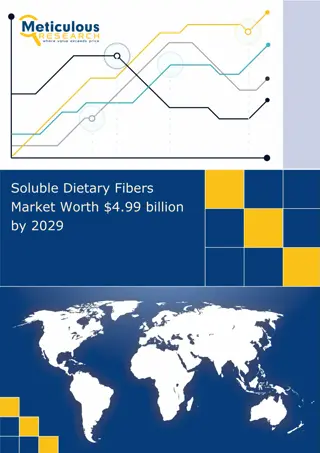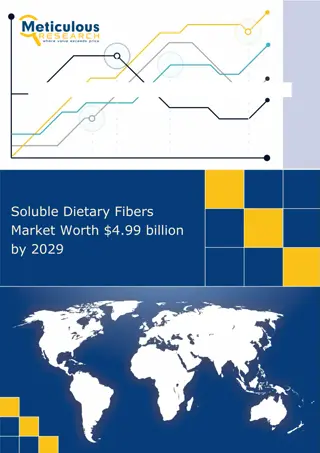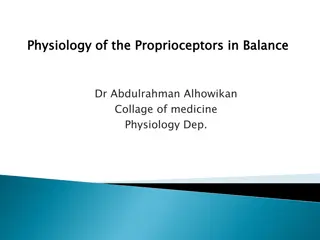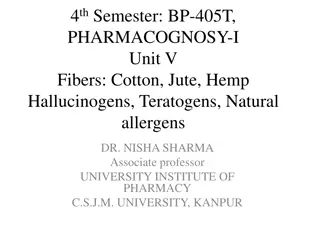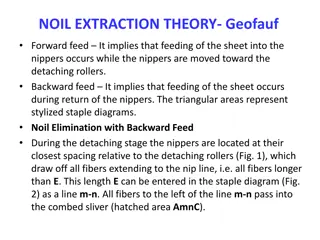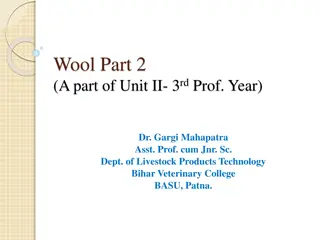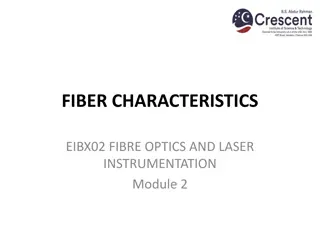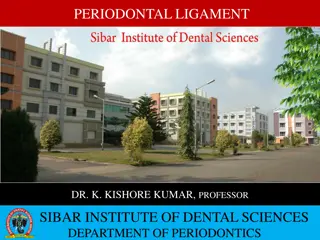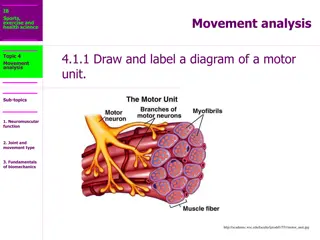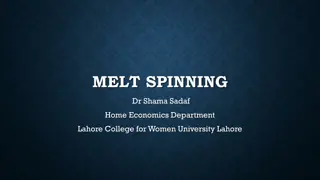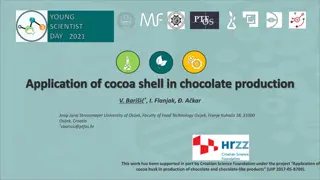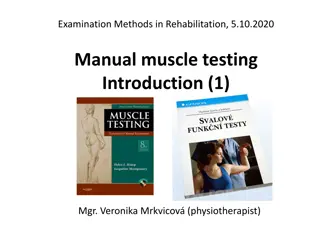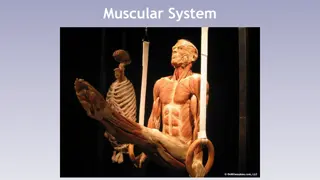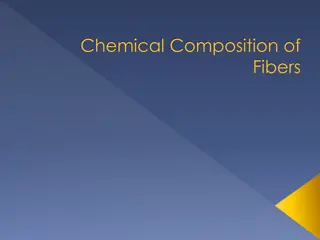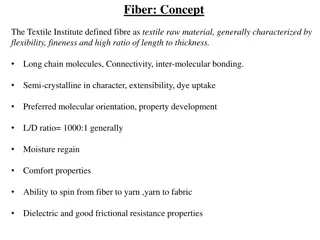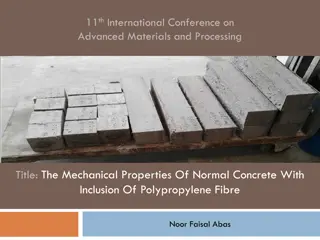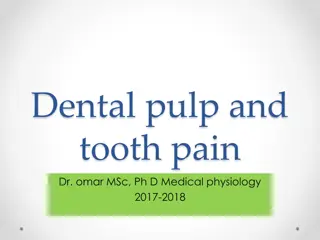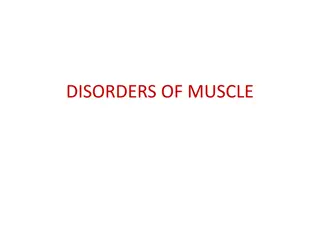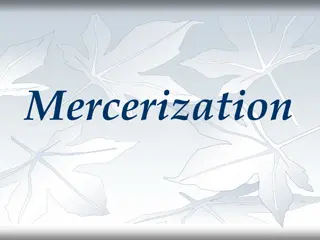SMALL FIBRE
Small fiber neuropathy involves thin and unmyelinated nerve fibers, leading to various sensory disturbances. The Erlanger and Gasser classification details the different types of nerve fibers involved. Symptoms include burning, tingling, and numbness, often presenting in a stocking-glove pattern. Di
4 views • 53 slides
Soluble Dietary Fibers Market Worth $4.99 billion by 2029
Nation-wide lockdowns in some regions have impacted the transportation of raw materials from suppliers. The temporary closures of manufacturing bases due to indefinite lockdowns and temporary quarantines impacted the growth of the soluble dietary fibers market during the pandemic.
0 views • 3 slides
Nerve and muscle physiology
The lecture delves into the intricate structure of nerves, highlighting the morphology of nerve fibers and the process of myelination. It explores the classification of nerve fibers, emphasizing the role of dendrites, axons, and synaptic functions in the nervous system. The significance of Schwann c
4 views • 29 slides
Skeletal Muscle Relaxants and Neuromuscular Blockade
Skeletal muscle relaxants are used to induce muscle relaxation during surgeries. Neuromuscular blocking agents act at the neuromuscular junction. These drugs can either peripherally reduce muscle tone or centrally cause muscle paralysis. Different types of muscle relaxants are classified based on th
5 views • 23 slides
Soluble Dietary Fibers Market Projected to Reach $4.99 Billion by 2029
According to this latest publication from Meticulous Research\u00ae, the global soluble dietary fibers market is expected to grow at a CAGR of 7.8% from 2022 to 2029 to reach $4.99 billion by 2029\n
1 views • 4 slides
Meticulous Research® Publishes Comprehensive Report on the Medical Laser Market Projecting $17.3 Billion by 2031
Medical Laser Market Size, Share, Forecast, & Trends Analysis by Type (Device Type (Solid-state Lasers, Gas Lasers, Dye Lasers, Diode Lasers), Fiber Type (Disposable Laser Fibers, Reusable Laser Fibers)), Application (Device, Fiber), and Geography -
1 views • 4 slides
Understanding Proprioceptors and Their Role in Body Balance
Proprioceptors play a crucial role in providing information about the position of body parts, muscle spindle response to stretch, and muscle tension regulation. Muscle spindles and Golgi tendon organs are key components in maintaining muscle tone and ensuring proper reflex actions. This article delv
1 views • 23 slides
Exploring Fibers: Cotton, Jute, and Hemp - Pharmacognosy Insights
Discover the world of natural fibers such as cotton, jute, and hemp in pharmacognosy. Learn about their biological sources, chemical constituents, uses, and classification based on origin. Delve into the properties and applications of these fibers, alongside insights on hallucinogens and their effec
0 views • 16 slides
Muscle Contraction Phases and Responses: A Comprehensive Overview
Various changes observed during muscle contraction include the latent period, contraction phase, and relaxation phase. Muscle twitch, tetanus, and their durations are important phenomena in understanding muscle physiology.
0 views • 14 slides
Understanding the Gate Control Theory of Pain in Pain Management
This detailed content delves into the Gate Control Theory of Pain, explaining pain pathways involving nociceptors, A-delta fibers, and C fibers. It further explores central pain pathways like the spinothalamic tract, spinomesencephalic tract, and spinoreticular tract. The theory's mechanism of pain
1 views • 11 slides
Noil Extraction Theory: Geofauf Forward and Backward Feed Methods
Noil extraction theory involves Geofauf forward and backward feed methods for processing fibers in textile manufacturing. Forward feed involves feeding the sheet into the nippers while moving towards the detaching rollers, while backward feed feeds the sheet during the nippers' return. The process i
0 views • 6 slides
Understanding Electromyography (EMG) and Motor Neurons
Electromyography (EMG) is an electrodiagnostic technique used to evaluate muscle health by measuring electrical activity. EMG measures muscle response to nerve signals, displayed as waves on an oscilloscope. Motor neurons transmit signals from the brain to muscles, enabling movement. Upper motor neu
1 views • 8 slides
Development of Wool Follicles in Sheep: A Detailed Overview
Wool production in sheep involves the development of wool follicles starting from the basal layer of the epidermis. The process includes the formation of follicles during gestation, thickening of the basal layer into a plug, growth of accessory structures like glands, and the differentiation of cell
0 views • 17 slides
Understanding the Histological Structure of Muscle Cells
This presentation delves into the histological structure of three types of muscle cells - skeletal, cardiac, and smooth muscles. Learn about their differences, such as striation, voluntary vs. involuntary control, and cellular organization. Discover the components of muscular tissue, the coverings o
0 views • 13 slides
Understanding Fiber Characteristics in Fiber Optics and Laser Instrumentation
This module explores the mechanical characteristics such as strength, static fatigue, and dynamic fatigue of glass fibers in fiber optics. It discusses the cohesive bond strength of glass fibers, static fatigue under humid conditions, and dynamic fatigue during installation and operation. The transm
0 views • 34 slides
Understanding the Periodontal Ligament in Dental Sciences
The periodontal ligament (PDL) is a vital connective tissue that supports teeth by attaching them to the jaw bone. It consists of various tissues including cementum and alveolar bone, and is rich in vascular and cellular components. The development of PDL fibers plays a crucial role in tooth support
1 views • 39 slides
Understanding Motor Units and Neurotransmitters in Muscle Contraction
Motor units consist of a motor neuron and the muscle fibers it innervates. Neurotransmitters like acetylcholine play a vital role in stimulating muscle contraction by transmitting signals at the neuromuscular junction. This communication between neurons and muscles is essential for proper movement a
0 views • 30 slides
Understanding Melt Spinning in Polymer Fiber Manufacturing
Melt spinning is a specialized extrusion process used for manufacturing polymer fibers at industrial scales. It involves melting the fiber-forming substance, extruding it through a spinneret, solidifying the filament, and applying spin finish. The method allows for shaping fibers in various cross-se
0 views • 10 slides
Overview of Laser Delivery Systems for Surgical Procedures
Institute of Laser for Postgraduate Studies at the University of Baghdad, led by Assist. Prof. Dr. Lutfi Ghulam Awazli, focuses on laser delivery systems in surgical procedures. The systems discussed include optical fibers, articulated arms, hollow waveguides, and free beams. Optical fibers, compose
0 views • 10 slides
Cutting-Edge Fiber to Chip Packaging for Quantum Applications
Cutting-edge research on fiber to chip packaging for quantum applications, showcasing low-loss techniques and advanced photonics devices. The study covers topics such as packaging multiple fibers, fabrication processes, fiber array fusion splicing, and transmission curves for multiple fibers. This w
0 views • 4 slides
Application of Cocoa Shell in Chocolate Production: Young Scientist Day 2021
Application of cocoa shell in chocolate production was explored at the Young Scientist Day 2021. The cocoa shell, a by-product rich in fibers, proteins, and bioactive components, is used in various applications including animal feed, mulching, and biodiesel production. High Voltage Electrical Discha
0 views • 6 slides
Understanding the Nervous System and Sensory Neurons
The nervous system plays a crucial role in connecting the central nervous system (CNS) to limbs and organs through the peripheral nervous system (PNS). It consists of sensory neurons that transmit impulses from sensory receptors to the CNS, allowing us to perceive and respond to various stimuli. The
0 views • 23 slides
Understanding the Nervous System: A Comprehensive Overview
The nervous system consists of the central nervous system (CNS) and peripheral nervous system (PNS), with neurons as its basic unit. Neurons function as sensory, associative, and motor types, carrying impulses within the body. Parts of a neuron include the cell body, dendrites, axon, and terminal en
1 views • 86 slides
Contribution of Quadriceps, Hamstrings, and Latissimus Dorsi Muscle Strength to Rowing Performance in West Java
Rowing is a demanding sport that requires strong leg muscle strength for optimal performance, particularly in West Java where rowing athletes train. This study aims to investigate the contribution of quadriceps, hamstrings, and latissimus dorsi muscle strength to the performance of rowing athletes i
0 views • 16 slides
Designing a Fun and Tech-Infused Charity Costume for Marathon Runners
Your task is to design a charity costume for marathon runners that promotes the cause effectively, looks engaging, and incorporates cooling technologies. Consider fabric type, ease of movement, and recyclable materials. Explore fabric options, from natural fibers like cotton and wool to synthetic fi
0 views • 18 slides
Understanding Spasticity and Increased Muscle Tone in Neurological Disorders
Spasticity and increased muscle tone are common features in neurological disorders, characterized by hyperactive stretch reflexes and muscle contractions. Spasticity is velocity-dependent and associated with upper motor neuron lesions, leading to increased resistance to passive movement. Rigidity, o
0 views • 28 slides
Evolution of Optical Fiber Technology
Optical fiber technology has a rich history starting from John Tyndall's demonstrations in 1870 to the development of flexible fiberscopes by Hopkins and Kapany. This technology revolutionized communication systems and medical diagnostics, enabling the transmission of information through thin glass
0 views • 85 slides
Understanding Types of Muscle Actions in Physiology
Explore different types of muscle actions, including isometric contractions, isotonic contractions, concentric contractions, eccentric contractions, isokinetic contractions, and iso-inertial contractions. Each type plays a crucial role in muscle function and movement, with varying effects on muscle
0 views • 14 slides
Importance of Manual Muscle Testing in Rehabilitation
The assessment of muscle function is crucial in various medical exams, showing correlations with quality of life, work productivity, and aging-related issues. Manual muscle testing is commonly used by healthcare professionals to evaluate muscle strength and guide treatment plans. Assessing muscle fu
0 views • 54 slides
Understanding the Muscular System and Its Anatomy
The muscular system is vital for movement, posture maintenance, and organ protection. It consists of skeletal muscles that contract to create movement, circular muscles called sphincters for controlling openings, and muscle fibers arranged in fascicles with collagen layers like epimysium and endomys
0 views • 59 slides
Understanding Vat Dyes: Properties, Dyeing Process, and Limitations
Vat dyes are known for providing excellent color and fastness properties to textile materials, especially natural and manmade fibers. The dyeing process involves steps like aqueous dispersion, vatting, absorption by fibers, re-oxidation, and soaping off to ensure colorfastness. However, there are ce
0 views • 25 slides
Overview of Fiber Chemical Composition and Types
Fibers consist of polymers made from simple molecules, with natural fibers like wool, silk, cotton, and linen having specific compositions including proteins, cellulose, and glucose. Man-made fibers like rayon and acetate are chemically altered cellulose, while synthetic fibers like nylon and polyes
0 views • 11 slides
Understanding Cellulosic Fibres in Textile Raw Materials
Fiber concept includes the flexibility and characteristics of fibers as textile raw materials, with a focus on cellulose, the most abundant polymer in nature. Cellulose fibers, such as cotton, exhibit unique structural properties and molecular formations that contribute to their properties in fabric
0 views • 25 slides
Understanding Skeletal Muscle Relaxants and Muscle Contraction Mechanisms
Skeletal muscle relaxants play a crucial role in relaxing muscles without affecting consciousness significantly. They are classified into neuromuscular blockers and spasmolytics, each targeting different mechanisms in the body. Muscle contraction occurs through the release of acetylcholine and the s
0 views • 27 slides
Understanding Connective Tissue Wrappings and Skeletal Muscle Structure
Exploring the connective tissue wrappings and attachments of skeletal muscles, this content highlights the cord-like structures, collagen fibers, and their role in connecting muscle bellies to bones. It also delves into the surrounding connective tissues such as fascia, epimysium, perimysium, and en
0 views • 11 slides
Mechanical Properties of Concrete with Polypropylene Fibre Inclusion
Concrete is a brittle material that is strong in compression but weak in tension. In this study, the focus is on enhancing the mechanical properties of normal concrete by including polypropylene fibers. The inclusion of fibers helps improve crack resistance and flexural strength, acting as crack arr
0 views • 17 slides
Understanding Dental Pulp and Tooth Pain: A Comprehensive Overview
Dental pulp, a soft connective tissue, plays a crucial role in tooth health. It consists of various cells and components like collagen, proteins, and growth factors. The innervation of dental pulp by sensory fibers influences pain perception, with different types of nerve fibers implicated in differ
0 views • 23 slides
Overview of Muscle Disorders and Muscular Dystrophies
The human body consists of over 600 muscles, divided into skeletal, smooth, and cardiac muscles. Diseases of skeletal muscle encompass myopathy, myositis, and muscular dystrophy. Muscle disorders are categorized into genetic muscular dystrophies, channelopathies, inflammatory myopathies, and endocri
0 views • 32 slides
Understanding Mercerization: Transforming Cotton Fibers
Mercerization is a chemical treatment method primarily used on cotton fibers to enhance their strength, luster, and absorbency. The process involves treating the fabric with a concentrated solution of Sodium Hydroxide, resulting in various improvements such as increased dye absorption, enhanced stab
0 views • 25 slides
Understanding Basic Histology and Tissue Types
Explore histology, tissues, and types of tissues including epithelial, connective, muscle, and nerve tissues. Learn about tissue characteristics, differences, and functions, as well as details on specific tissue types like cardiac muscle, bone tissue, skeletal muscle, and smooth muscle. Delve into e
0 views • 74 slides

